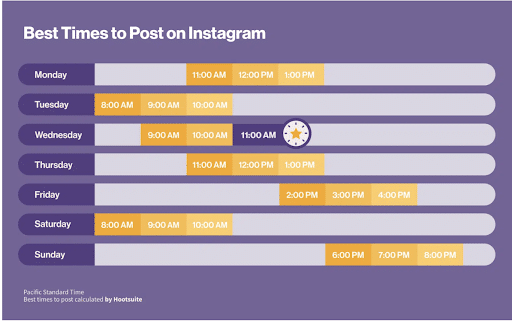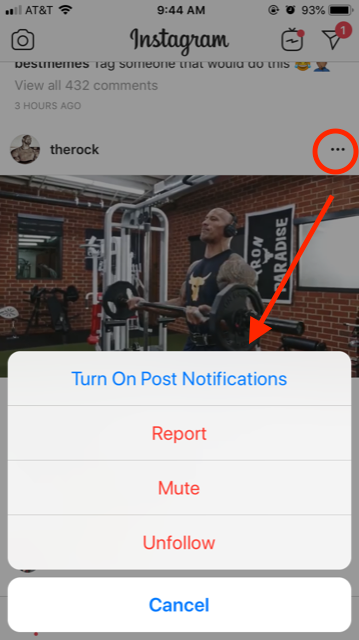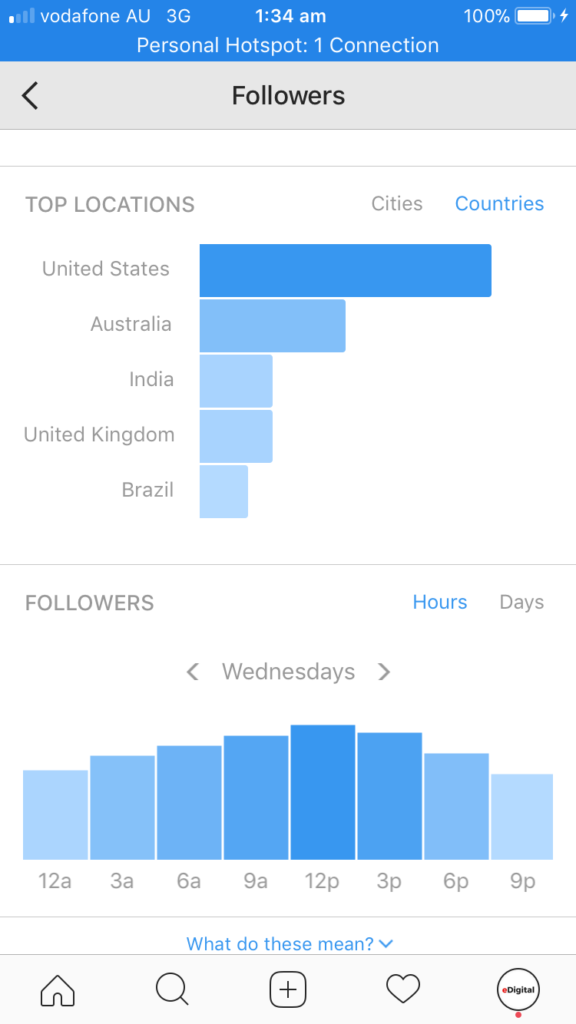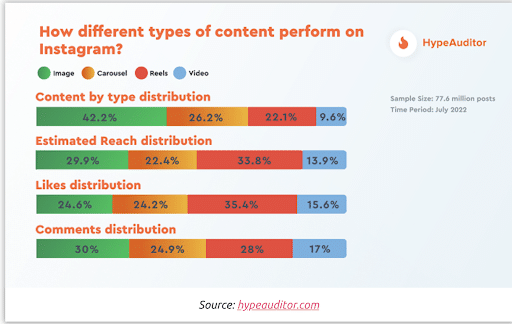Wondering when’s the best time to post on Instagram?
It’s the million-dollar question, and the answer isn’t as straightforward as you might think.
Here, we’ll take a closer look at how to perfectly time your Instagram posts whether you’re B2B or B2C.
Times have changed since Instagram was a reverse-chronological feed. No longer does the platform show the freshest posts first. It also considers interest, frequency, relationships, and how many accounts you follow.
In this article, you’ll learn:
- Why Timing Matters
- What is the Best Time to Post on Instagram?
- How Does the Algorithm Affect Timing?
- What Are the Best Times to Post on Instagram By Industry?
- Determining the Best Time to Post
- Does the Best Time to Post Differ Based on Post Type?
- Best Times to Post on Instagram FAQs
Why Timing Matters For Instagram Posting Times in 2023
While timing isn’t everything, brands can’t just post whenever they feel like it. Recency is a ranking factor, after all.
Brands should aim to post when their followers are online. To grow a following, brands need to create content their audience wants to see. But, if you take timing out of the equation, followers might have a hard time finding that killer content you worked so hard on.
According to Pew Research, half of all Instagram users scroll through the app every day. Still, engagement rates vary based on when and what you post.
The timing of a successful post on Monday is going to be different than one on a Sunday. A lot of factors need to be considered when working out your content posting schedule.
What is the Best Time to Post on Instagram?
Easily put: the best time to post on Instagram is when your users are most online. Since the Instagram algorithm is designed based on user habits, your posting schedule should follow it, too.
Users tend to check the app when they have a moment to spare. While you’re figuring out which time of the day is best for your followers, you can start posting at times that are pretty busy overall.
According to HootSuite, the best time and day to post in general is 11 am on Wednesday.
As you can see from the chart below, posting during the day on a weekday is pretty much always a good idea. This is probably because people often scroll through Instagram while taking a break at work or school.

Best Times to Post on Instagram
Want to break it down even further? Here are the best times to post each day:
- Monday: 12:00 PM
- Tuesday: 9:00 AM
- Wednesday: 11:00 AM
- Thursday: 11:00 AM
- Friday: 2:00 PM
- Saturday: 9:00 AM
- Sunday: 7:00 PM
If you don’t want to commit to a particular time on any given day, your next best bet is to post at the best general time of the day. According to Later, this is 4 am. This doesn’t take day into consideration, only time. If you miss posting at 11 am on Wednesday, aim for 4 am on any day of the week.
While these are good times in general, the best way to find success on Instagram is to find your brand’s sweet spot. To do this, play around with timing and measure your findings. Schedule posts at different times so you can be a part of your followers’ lunch breaks and morning routines whether they’re on the East Coast, West Coast, or in another country.
Of course, that gets a bit tricky if you’re operating on a global scale and therefore, have to consider the optimal time zone for multiple locations.
Ultimately, answering the “when is the best time to post on social media” question depends on more than considering the traditional 9-5 work week. It also depends on the industry and what kind of content you post.
While timing is probably the most important factor in Instagram’s algorithm decisions, you should also take other things into account, like:
- Day of the week
- Typical breaks in the workday
- Time Zone
- Audience behaviors and engagement
- Frequency of posting
On that note, let’s take a look at how the Instagram algorithm, in its current iteration, impacts timing.
How the Instagram Algorithm Affects Timing
During Instagram’s first six years, the content was presented in reverse chronological order regardless of quality or relationship. So for brands, timing literally was everything.
But in 2016, Instagram announced that they were going to switch things up by prioritizing the “moments you care about” over the most recent posts in your feed. While the goal was creating a high-quality feed, the change didn’t go over so well with users.
Automatic refreshes made users lose their place, brands felt that their content wasn’t reaching customers, and a Change.org campaign entitled, Keep Instagram Chronological made the rounds on the web.
In 2018, the platform updated the algorithm again, this time building “recency” back into its signal lineup. Since Instagram has made new content a priority, brands do need to consider when their audience is most active to get the most mileage from their posts.
While Instagram stated they’d never go back to an entirely chronological feed, the most current iteration is something of a compromise. Feeds are personalized based on a handful of factors such as how users interact with the content, as well as timeliness, interest, and engagement.
In 2022, Instagram made a major few changes that included highlighting video content, specifically Reels, using AI to generate recommendations, and full-screen feed videos (no more square posts!).
Not all of these changes were welcomed with open arms but a few are definitely here to stay, such as video content. When you produce high quality content, specifically short-form video content, Instagram will start to push your content to more people.
Regardless of what happened to the 2022 updates, it served as a good reminder that no social media platform’s algorithm is set in stone. Anyone in digital marketing should keep up with all of the latest changes.
Here’s a little about what those other ranking factors mean for your brand and how it affects when the post time to post on Instagram is for you.
You’ve Got to Be Interesting
Posting during peak hours means nothing if your content lacks personality.
Instagram’s machine-learning algorithm aims to deliver the content you care about based on how you’ve interacted with similar content in the past.
Brands can take advantage of this by focusing on engagement and being authentic. What this means is, identifying hashtags that will help you get seen, along with high-quality visuals, and well-crafted captions. In other words, your goal is to push out posts people actually want to click on.

Aside from timing, your posts will only perform well if they’re interesting. Use high quality, color schemes and hashtags. Image courtesy of Instagram user JuniperOats
Relationship Building Matters
The relationship element of the algorithm tries to determine the depth of a relationship between an account and its followers. This is where the “meaningful” content part comes in.
Instagram’s initial shift toward a more relevant feed sought to emphasize deeper connections, not engagement baiting or promotional spamming.
Use Instagram Insights to learn more about your follower personas and use that data to determine what kind of content to post.
Additionally, you can also increase engagement by commenting on followers’ accounts and responding to comments while they’re still fresh.
Tell Your Followers How to Turn On Notifications
Instagram offers a feature that allows you to turn on notifications if one of your favorite accounts posts something new.
Remind followers that they can turn on notifications “so they don’t miss anything” by tapping the three dots icon on your page and selecting “turn on post notifications.”
While you don’t want to badger your followers into receiving notifications, a friendly reminder every now and then may result in getting more engagement on your IG videos.

Outside of finding the best time to post on Instagram, you should tell followers to turn on post notifications
Run Paid Promotions
If your goal is to grow an audience, Sponsored Posts are a great way to put your content in front of a new crowd. Timing doesn’t come into play here, as Instagram handles the scheduling process for paid ads.
As with organic content, brands need to make sure they’re targeting the right demographic and paid ads feature compelling captions and eye-catching photos.
Don’t Forget to Use Relevant Hashtags
There’s been some talk lately that hashtags are dead. This isn’t true. It’s no secret that Instagram posts featuring relevant hashtags receive higher engagement than those without. Use a mix of branded and community hashtags to increase your reach by helping you show up in related search results.
The Best Times to Post on Instagram by Business Type
When determining when’s the best time to post on Instagram, optimal posting time varies by industry.
B2B brands benefit from scheduling posts around the workday. B2C brands do better during typical break times or on the weekends. That makes sense, right? B2B customers are going to be looking for connections during their work day but once they’re off the clock, finding vendors and connections for work isn’t at the top of their list of things to do.
When it comes to B2C, the best times to post on Instagram vary per industry and product. Sprout Social reviewed a variety of industries and their findings were quite interesting.
Here are some of the highlights of what they found, regarding the best times to post on Instagram:
- Consumer Goods:
- Best Times to Post: Thursdays at 2 pm
- Best Days to Post: Tuesdays and Thursdays
- Worst Days to Post: Sundays
- Hospitals & Healthcare:
- Best Times to Post: Thursdays at 1 pm
- Best Days to Post: Tuesdays, Thursdays, and Fridays
- Worst Days to Post: Sundays
- Hospitality:
- Best Times to Post: Tuesdays at 10 am, Wednesdays from 11 am to 1 pm, Thursdays at noon, and Fridays at 10 am to noon
- Best Days to Post: Tuesdays and Wednesdays
- Worst Days to Post: Sundays
- Media:
- Best Times to Post: Mondays at 11 am, Wednesdays at 11 am, and Thursdays at 10 am
- Best Days to Post: Mondays, Wednesdays, and Thursdays
- Worst Days to Post: Saturdays and Sundays
- Nonprofit:
- Best Times to Post: Tuesdays at 10 am to 1 pm, Wednesdays at 11 am to 5pm, and Fridays at 10 am to noon
- Best Days to Post: Wednesdays
- Worst Days to Post: Saturdays and Sundays
- Restaurants:
- Best Times to Post: Mondays at 2 pm and Mondays from 4 to 6 pm
- Best Days to Post: Mondays
- Worst Days to Post: Thursdays, Saturdays, and Sundays
- Schools & Education:
- Best Times to Post: Tuesdays at 11 am and from 1 to 4 pm, Wednesdays at noon and 3 pm, and Thursdays from 10 am to noon
- Best Days to Post: Tuesdays
- Worst Days to Post: Sundays
- Travel & Tourism:
- Best Times to Post: Tuesdays at 10 am
- Best Days to Post: Tuesdays and Wednesdays
- Worst Days to Post: Thursdays, Saturdays, and Sundays
If you look at some of these findings, they make sense. Take Travel & Tourism for example, people are going to be dreaming of getting away in the middle of the week, which is why Tuesdays and Wednesdays are the best days to post in that industry. On Saturdays and Sundays, they’re probably busy doing other things, such as sports with their kids, doing housework, or actually traveling.
If there’s one thing that seems clear across the board, it’s that Sunday is not a good day to post for any industry. Again, this makes sense. Usually on Sunday, people are busy with family events or functions and getting ready for the busy week ahead. They aren’t necessarily scrolling through social media as much.
Based on this information, brands should schedule posts ahead of time—particularly those related to important campaigns—so that something goes out at your “optimal times.”
How to Determine the Best Time to Post for Your Brand
The Sprout and HootSuite reports are an excellent place to start if you’re looking for a sort of “benchmark” of the best time to post on Instagram to get the most views.
But, as good as this research is, they aren’t looking at your particular brand or the fact that every social marketing platform has revealed slightly different insights. This doesn’t necessarily mean anything is wrong; it just means that there’s no one-size-fits-all approach to timing.
So to get the most accurate read on when it is best to post on Instagram for your brand specifically, you’ll need to get up close and personal with your analytics.
Digging into the analytics will give you a better idea of what works for your audience. We recommend heading over to Instagram’s Insights to learn more about the best times for your audience.
Keep in mind, that these Insights are only available for Business accounts.
To access them, go to Insights and hit the Audience option. From there, scroll down the page, and you’ll see the days and times that your followers are most likely to be online.
These reports reveal that maybe if you work in personal care, your audience preferences might overlap with brands like MAC or Kylie Cosmetics. But, you’ll want to check your Instagram analytics to see if that’s actually the case.

To find the best time to post Instagram, you’ll need to use Instagram Insights
After you’ve used Instagram Insights to find the approximate times your followers are online, try playing around with specific times to see if there’s an optimal hour for engagements.
For example, if your insights say that your followers are most active from 3-8 PM, try posting at 4, 5, and 8 PM and compare the results.
Identify Your Top Time Zones
Schedule your posts according to follower time zones, not what’s convenient for you. If most of your followers are on the East Coast, and you’re based in California, schedule posts based on EST peak hours, not yours.
Get the Demographic Breakdown
Again, it’s in your best interest to learn more about your audience.
This information (found in your Insights account) will highlight interests, age, and location breakdowns, as well as the days and times that perform best.
Plan Around the Workday
Unless your channel is all about shopping, you’ll want to avoid posting critical updates on the weekend. Stick to the mid-week for maximum engagement, but pay attention to how slight changes impact engagement.
More Posts Mean More Data
The more you post, the more data you’ll have at your fingertips. Over time, you’ll start to get a sense of which types of content work best and if there’s a difference between posting a video on Monday night versus Saturday afternoon.
Is Timing Different for Content Types?
When asking yourself ‘when’s the best time to post on Instagram,’ you need to take all formats into account.
Since engagement is so important to Instagram’s algorithm, it’s important to remember that some content tends to perform better than others, regardless of timing. For example, HypeAuditor found that, overall, Reels reach more people and receive more likes and comments than any other type of content on Instagram.

Instagram Content Performance
Still, remember that this is a generalization. You should still experiment with this yourself to see how different types of content perform with your target audience. Keep in mind that users might not want to listen to videos during the workday and some users are hearing impaired, so add captions to your Reels to make them more accessible for a wider audience.
This is another instance where your best bet is to analyze what content resonates most with your audience. They might not respond to static photos as much as Live video. If that’s the case, then adjust your strategy to give the people what they want.
Frequently Asked Questions
1. How does Instagram’s ‘Recent’ vs. ‘Relevant’ feed setting impact posting times?
Instagram’s ‘Recent’ vs. ‘Relevant’ feed setting can affect when you should post. While ‘Recent’ will present content in chronological order, ‘Relevant’ uses an algorithm. The impact on posting times varies, so it’s crucial to monitor your audience’s behavior.
2. How frequently should I post on Instagram for optimal engagement?
This depends largely on your audience and the type of content you want to share. Consistency is key, but posting too often can overwhelm your audience. High-quality content should be what guides your posting schedule.
3. Does the ideal posting time vary for Instagram Stories vs. Feed posts?
Yes, the ideal posting time varies for Instagram Stories and Feed posts. Stories have a shorter lifespan, so real-time engagement is important. Feed posts benefit from strategic timing so you can reach your target audience when it matters most.
4. How do holiday seasons or special events affect the best time to post?
Holidays and special events can impact posting times. Audience behavior may change during these periods, so it’s crucial to continually adjust your posting schedule to align with your target audience’s availability.
5. Are weekends more effective for certain niches or industries on Instagram?
Yes, weekends can often be more effective for specific niches or industries on Instagram. This is because people generally have more free time to browse their social media channels on the weekends. However, you’ll likely need to analyze your audience’s behavior to determine the best method.
6. How can using Instagram Insights help refine my posting schedule?
Leveraging Instagram Insights is a great way to refine and improve your posting schedule. It provides invaluable data on when your audience is most active and engaged online, helping you make data-driven decisions about the best times to post on Instagram.
7. What role do IGTV and Reels play in post-timing strategies?
IGTV and Reels have different dynamics than regular Instagram posts. For IGTV, longer-form content can perform better at certain times, while Reels, which are shorter and more entertaining, may have their own ideal posting windows. Understanding your audience’s preferences is vital.
8. Do collaborations or shoutouts affect the best times to post?
Collaborations and shoutouts can influence your posting times. Coordinating with collaborators’ schedules and considering their audiences can impact the success of your posts. Collaboration timing should align with the shared audience’s active hours.
Wrapping Up
So, what’s the best time to post on Instagram?
It depends. Overall, the best time to post on Instagram is 11 am on Wednesdays. However, the best way to find success is to do some experimenting of your own. Finding what your audience likes and reacts to best will help you grow your Instagram page and find the results you’ve been looking for.
Finding the best time to post on Instagram is one step toward growing your audience, but it’s not the only thing to consider.
Instagram marketing success depends on a lot of trial and error, as well as understanding your followers. The algorithm is designed to give users a feed that works for them. Focusing on timing alone won’t give you the best possible outcome. It’s all about the full package: interesting, empathetic, and timely content.
Want to Improve Your Social Media Marketing?
If you need help navigating the crazy waters of Instagram and social media marketing, Ignite Visibility has a team of expert digital marketing professionals. We leverage the power of Instagram, both organic content and paid media, to help businesses drive targeted traffic and achieve their marketing goals. Our expert strategists work closely with clients to understand their unique needs and design customized performance-based campaigns that maximize return on investment.
Want to learn more about using Instagram for business and social media marketing services?